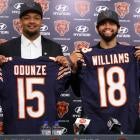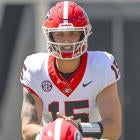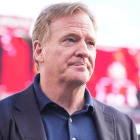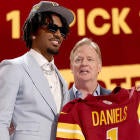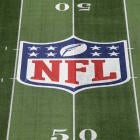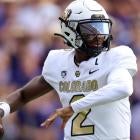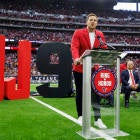The Seattle Seahawks' quest to become the first team in the salary cap era to reach the Super Bowl in three consecutive seasons fell short with a 31-24 defeat to the Carolina Panthers in Sunday's divisional playoff game. A 31-point deficit proved to be too much to overcome.
Seahawks coach Pete Carroll aptly described the slow start against the Panthers as a microcosm of the season. The Seahawks dug themselves a hole before rebounding from a 2-4 start to finish the season with a 10-6 record to make the playoffs for the fourth year in a row.
Here's a look at what lies ahead for the Seahawks and the nucleus of talent from their Super Bowl teams.
Beast Mode's farewell
Life without Marshawn Lynch once seemed like a daunting proposition since Lynch had been the driving force behind Seattle's offense. A changing of the guard took place this season with Lynch limited to seven regular season games because of multiple injuries. An abdominal injury requiring surgery kept Lynch out of action from Week 11 until his return for Sunday's season-ending loss in Charlotte.
Thomas Rawls, who entered the NFL in 2015 as an undrafted free agent, emerged as Lynch's successor before a broken ankle in Week 14 ended his season. Rawls rushed for 830 yards and led the NFL with 5.6 yards per carry. The offense also exploded without Lynch, averaging 32 points per game in his absence, while Russell Wilson showed dramatic improvement as a pocket passer.
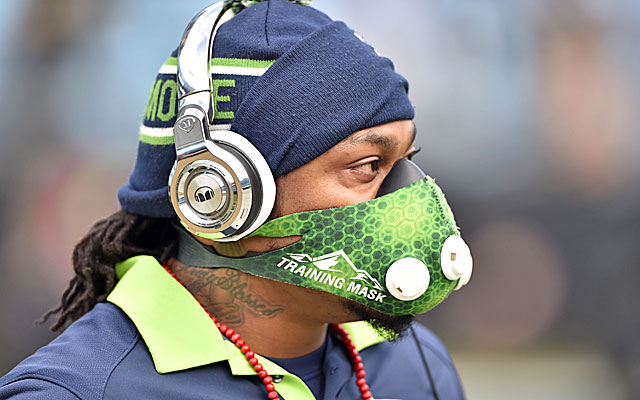
Beast Mode's days in Seattle appear to be numbered because of his age, salary and Rawls' presence. Lynch turns 30 in April and the two-year, $24 million contract extension with $12 million guaranteed that he received in the offseason has an $11.5 million 2016 salary cap number. Only Adrian Peterson has a larger 2016 cap number for a running back at $12 million.
The five-time Pro Bowler could make a parting of the ways easy for Seattle by retiring. Lynch contemplated ending his football career before signing the extension. Regardless of whether Lynch retires, is released or traded, which is unlikely because of his $9 million 2016 salary, the Seahawks will pick up $6.5 million of cap room from his departure.
Navigating the salary cap
The Seahawks are tackling the challenge of making the rare transition from a championship caliber team having a low-paid quarterback to a contender with a quarterback on a lucrative contract. Wilson's cap number jumps to a team-high $18.542 million in 2016, which is the first new year of the four-year, $87.6 million extension containing $61.542 million in guarantees he received at the start of training camp.
Seattle planned for the changing cap dynamics by becoming one of the NFL's more proactive teams in signing key young players to contract extensions prior to free agency being reached. Seven core players, including cornerback Richard Sherman, safety Earl Thomas, middle linebacker Bobby Wagner and Wilson, were re-signed to contracts worth over $300 million since winning Super Bowl XLVIII in February 2014.
Wilson is the only offensive player of the bunch, which is understandable because the team's identity has been the defense. The Seahawks are first in the NFL in total defense (284.7 yards per game) and scoring defense (15.7 points per game) over the last four seasons (2012-2015).
NFL teams were informed at a league meeting in December that the 2016 salary cap is preliminarily projected to be between $150 million and $153.4 million. When the 2016 salary cap is set in late February or early March, the expectation is for it to be at the high end of projections if not over the preliminary numbers like in the last two years.
During the offseason, only the top 51 cap numbers count on the salary cap. The Seahawks have slightly more than $123.875 million in 2016 cap commitments with 36 players under contract. Approximately $11,500 of unused cap room can be carried over from the 2015 league year. After accounting for tenders for restricted free agents and exclusive rights players with expiring contracts, futures contracts for practice squad players and earned incentives, Seattle should have a little more than $16.325 million of 2016 cap space assuming a $153.4 million salary cap. The total will increase to approximately $22.825 million if ties with Lynch are cut quickly.
The Seahawks have been quicker than most teams to admit player acquisition mistakes (i.e.; Matt Flynn and Percy Harvin). Although another $9 million of cap space could be freed up by moving on from tight end Jimmy Graham, who wasn't a good fit before tearing the patellar tendon in his right knee 11 games into the season, Carroll has said he figures prominently in Seattle's plans next season.
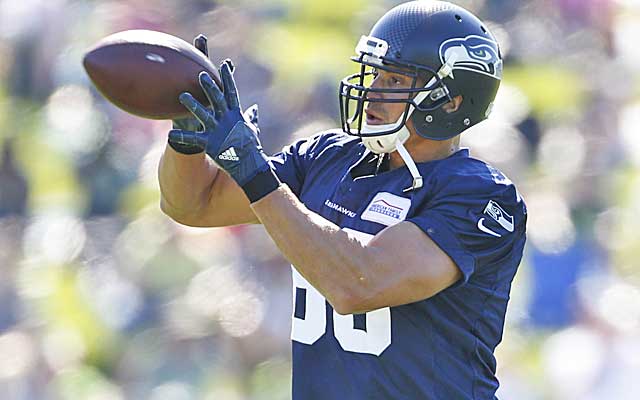
Free agency and team needs
The Seahawks have 17 unrestricted free agents, including linebacker Bruce Irvin, cornerback Jeremy Lane, defensive tackle Brandon Mebane, wide receiver Jermaine Kearse, offensive tackle Russell Okung, punter Jon Ryan, defensive tackle Ahtyba Rubin and offensive guard J.R. Sweezy. Six players, including guard/tackle Alvin Bailey, center Patrick Lewis and running back Christine Michael, are slated to become restricted free agents.
It probably won't be necessary to tender potential restricted free agents Derrick Coleman (FB), Ricardo Lockette (WR), and Nick Moody (LB) for $1.651 million, which is the lowest possible amount with a $153.4 million salary cap. Cap projections reflect these three players becoming completely free from not receiving a restricted free agent tender.
Seven starters, four on offense and three on defense, will be able to test the open market. Another starter, cornerback DeShawn Shead, also has an expiring contract. He is an exclusive rights player that will likely re-sign for one year at his $760,000 league minimum salary.
Seattle's "Can't Keep Everyone" principle will be in operation once again during the offseason. Offensive line, a big area of concern, is likely to continue having turnover. Seattle hasn't made a much of a financial investment in veteran offensive line contracts. The preference has been to address the offensive line outside of the first round of the NFL Draft where college defensive linemen are routinely converted. This philosophy puts a lot of pressure on offensive line coach/assistant head coach Tom Cable to develop talent.
Okung may find that representing himself isn't as easy as he thinks unless he can honestly assess his performance. He hasn't consistently played at a high level since his 2012 Pro Bowl season, partially due to injury. Okung could price himself out of Seattle. The 2010 sixth-overall pick probably took note of the five-year extension that Trent Williams received from the Washington Redskins in the preseason, since they were two picks apart in the draft. Williams' five-year, $66 million extension with $41.25 million in guarantees made him the NFL's highest-paid offensive lineman. Okung probably won't be interested in returning on a new contract that's less than the six-year, $48.5 million deal (with $29.3 million guaranteed and worth a maximum of $58 million) he signed in 2010 as an unproven commodity.
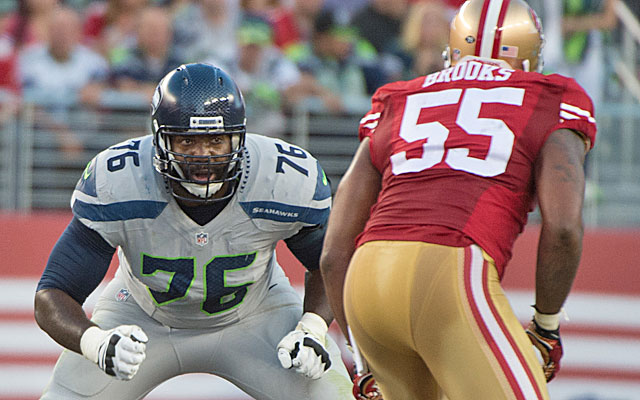
Sweezy may view the four-year, $19.1 million deal James Carpenter, Seattle's former left guard, received from the New York Jets during the offseason in free agency as a salary benchmark. Carpenter's contract may be too rich for Seattle's blood. Lewis, who helped solidify the offensive line once he was inserted into the starting lineup, and backup guard/tackle Alvin Bailey should receive the $1.651 million restricted free agent tender.
Losing Okung may make keeping a first-round pick for the time since 2012 a necessity in order to find a left tackle. Injury prone five-time Pro Bowler Ryan Clady could be a possibility if the Denver Broncos make him a salary cap casualty.
Another option could be another bold move like the one that brought Jimmy Graham to Seattle at the beginning of this season's trading period. The Cleveland Browns almost dealt perennial All-Pro left tackle Joe Thomas to the Broncos at the trading deadline. Talks broke down over additional compensation other than Denver's 2016 first-round pick. Seattle has the 26th overall pick in the upcoming draft. Thomas, whose 2016 salary is $9.5 million, is under contract though the 2018 season for $29.5 million. Seattle could restructure his contract after a trade to make it more cap-friendly for 2016 if necessary.
Defensive tackle could be a pressing need because of the expiring contracts of Mebane and Rubin. It might take Mebane accepting a short-term deal with an average a lot closer to Rubin's one-year, $2.6 million deal (worth up to $3.1 million through incentives) than the $5.5 million he made this season. Rubin will be looking for a bigger payday and more security after taking a one-year deal. Serious consideration should also be given to selecting an interior defensive lineman in the first round if the Seahawks keep their pick.
Irvin may be moving on in free agency despite his willingness to re-sign for a slight hometown discount after Seattle turned down a fifth-year option with him for $7.751 million last spring. Signing another linebacker to a lucrative contract was always going to be a challenge after taking care of Wagner and K.J. Wright. Since familiarity can bring comfort in the NFL, Irvin has enough former Seattle assistants as defensive coordinators (Ken Norton, Jr. of the Raiders) and head coaches (Gus Bradley of the Jaguars and Dan Quinn of the Falcons) to have options. A situation where Irvin will get more of an opportunity to rush the passer than in Seattle could be appealing.
The Seahawks have had a mass exodus at cornerback in recent years with Brandon Browner, Byron Maxwell and Walter Thurmond moving on in free agency. The defections finally caught up with Seattle until Shead replaced free agent pickup Cary Williams, who was eventually released, in the starting lineup and Lane returned from the torn ACL and broken arm he suffered in Super Bowl XLIX. More of an effort to retain Lane than previously with the other cornerbacks could be made to maintain continuity in the secondary.
2015 third-round pick Tyler Lockett's surprising contributions as a wide receiver decrease the urgency of re-signing Jermaine Kearse. The Washington state native may have to give the Seahawks a hometown discount to stay, despite career bests of 49 receptions, 685 receiving yards and five touchdown catches this season.
Extending Doug Baldwin's contract might be a part of the offseason agenda since he is scheduled to become an unrestricted free agent in 2017. Baldwin became Seattle's first player to crack the 1,000-yard receiving mark since Bobby Engram in 2007. During the second half of the season, Baldwin was one of the NFL's most productive pass catchers with 47 receptions (10th in the NFL), 724 receiving yards (6th in the NFL) and an NFL best 12 receiving touchdowns. Baldwin would be justified in seeking a deal exceeding the one Seattle gave Harvin, which averaged $11,166,667 per year and contained $25.5 million guaranteed, when he was acquired in 2013 from the Vikings via trade.
Disgruntled players
Kam Chancellor's unhappiness with his contract didn't magically disappear because he ended his ill-fated 54 day holdout. The issue is going to rear its head again, especially after Eric Berry signs a lucrative contract that dwarfs Chancellor's deal, whether it's in free agency or to remain with the Kansas City Chiefs. The Vikings are probably going to extend Harrison Smith's contract during the offseason. His new deal should be in the same neighborhood as Berry's. Chancellor will have two years worth $12.225 million remaining on the four-year, $28 million extension he signed in 2013, which made him one of the NFL's highest-paid strong safeties.
Addressing Chancellor's situation won't be as problematic as this season because a new precedent wouldn't be established. Seattle made some minor changes to Lynch's contract with two years remaining in 2014 where he received a $1 million raise for the season when he ended his eight-day holdout. The Seahawks were reportedly willing to move $3.1 million of Chancellor's $7,125,008 2017 salary to his 2016 contract year in which he is currently scheduled to make $5.1 million before Paul Allen, who is typically a hands-off owner, tabled discussions. Chancellor reportedly wanted to make $9 million in 2016. The Seahawks weren't interested in trading Chancellor during his holdout. It remains to be seen whether that changes if Chancellor insists on extension of his contract.
A major concern about accommodating Chancellor is how it would affect Michael Bennett, who was also unhappy with a contract that had three years remaining but decided not to hold out. Bennett has more of a reason to be disgruntled than Chancellor because he is much more underpaid. The four-year, $28.5 million contract he signed in 2014 will have two years for $12.5 million left once the playoffs end. Bennett would easily be worth over $11 million per year on the open market.
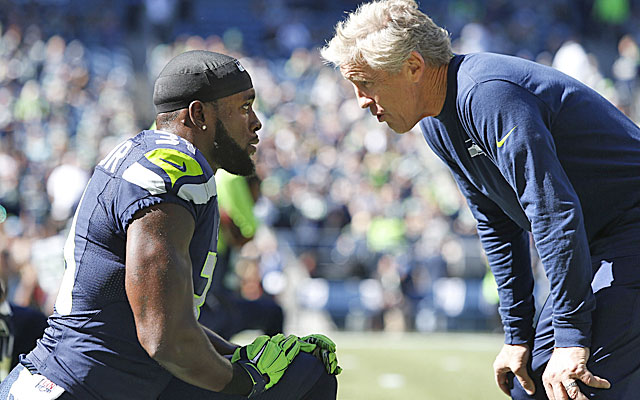
One change to his contract that Bennett should pursue is the conversion of his $1 million and $1.5 million of per-game 46-man active roster bonuses in his 2016 and 2017 contract years to base salary. For each game Bennett isn't on the active roster in 2016, he loses $62,500. It's $93,750 per game in 2017. Colin Kaepernick is a good illustration of how costly these roster bonuses can be. He lost $875,000 this season when a shoulder injury sidelined him for the final seven games because his 46-man active roster was for $125,000 each game ($2 million total).
Outlook
Seattle's championship window should remain open for an extended period of time because Wilson started demonstrating he could shoulder more of the offensive load, much like Tom Brady and Ben Roethlisberger have done as their careers progressed, while playing from the pocket. He had an unprecedented five-game run from Week 11 to Week 15 where he threw 19 touchdown passes without an interception while completing 74.3 percent of his passes for a 143.6 passer rating.
The Seahawks had a top-five offense (scoring and total yards) this season for the first time in Wilson's four-year career. This could continue as Wilson improves with Rawls succeeding Lynch, provided that addressing the offensive line becomes more of a priority.
General manager John Schneider has done an excellent job of identifying talent that fits Carroll's vision, especially with undrafted players and in the latter part of the draft. There isn't a reason to think that will change. Seattle should also be a favored destination for talented free agents once it becomes a buyer's market in the secondary phases of free agency because of the franchise's recent success.
A threat to Seattle's window of opportunity is potential changes to the organizational structure. Carroll will be a lame duck head coach unless his contract is extended beyond next season. Because of his unbridled enthusiasm, it's easy to forget that Carroll is the NFL's oldest head coach at 64 years old. The NFL returning to Los Angeles, where Carroll resurrected the USC Trojans before taking over the Seahawks, might make going back to Southern California to coach or in a front office capacity intriguing to him.
Joel Corry is a former sports agent who helped found Premier Sports & Entertainment, a sports management firm that represents professional athletes and coaches. Before his tenure at Premier, Joel worked for Management Plus Enterprises, which represented Shaquille O'Neal, Hakeem Olajuwon and Ronnie Lott.
You can follow him on Twitter: @corryjoel | You can email him at jccorry@gmail.com












